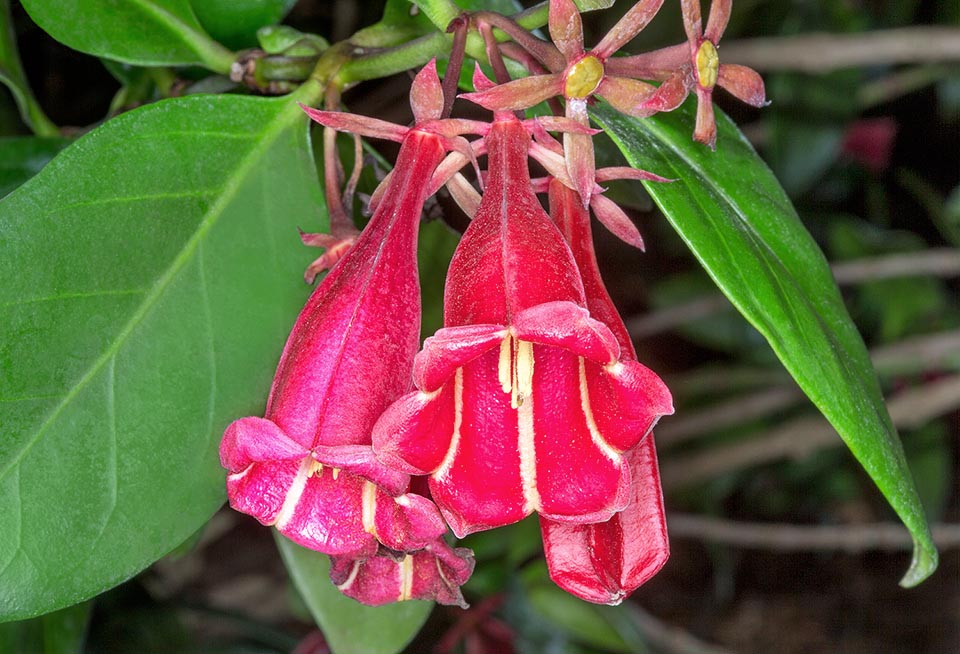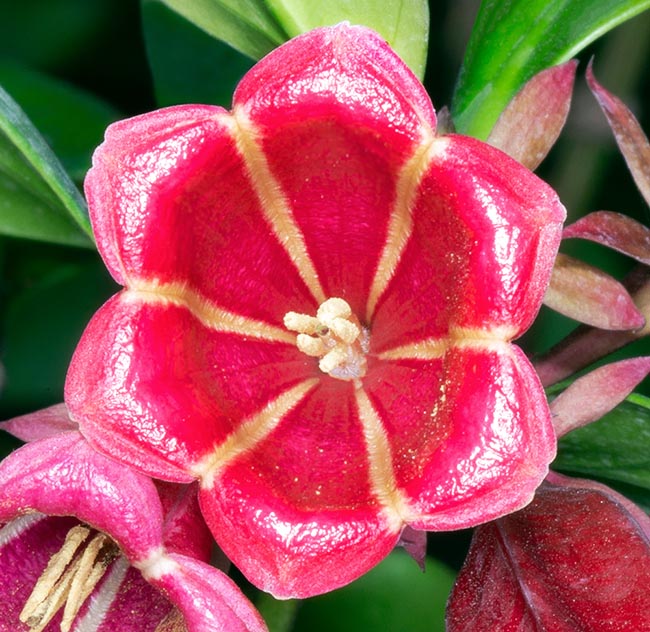Family : Rubiaceae

Text © Pietro Puccio

English translation by Mario Beltramini
The species is native to Jamaica (Saint Catherine), where it grows in the under-wood on calcareous rocky slopes, confined in a restricted area between the 200 and 300 m of altitude.
The genus was dedicated by the Irish botanist and physician Patrick Browne (1720-1790) to the duchess of Portland, Margaret Cavendish Bentinck (1715-1785), lover of botany, collector and deep connoisseur of the English flora; the species is dedicated to its collector, the American botanist George Richardson Proctor (1920-2015), scholar of the Caribbean flora.
Common names: crimson portlandia, pink bell flower, Proctor’s bellflower, red portlandia (English).

Rare in nature and poorly known in the nurseries, Portlandia proctorii is a Jamaica shrub or small tree, slow growing, that may be 3 m tall © Giuseppe Mazza
The Portlandia proctorii (Aiello) Delprete (003) is a shrub or an evergreen slow growing small tree, erect, 0,5-3 m tall, with bark of pale brown colour fissured longitudinally.
The leaves, sessile or on an up to 0,5 cm long petiole, are simple, opposite, obovate-elliptic with acute apex, cuneate to attenuated base and entire margin, 4-12 cm long and 2,5-6 cm broad, of glossy dark green colour above, paler below, rather coriaceous.
Cymose inflorescences at the axil of the upper leaves bearing 1-3 hermaphrodite flowers, on a 1-1,5 cm long pedicel, of dark pink to dark red colour, at times with 5 white lines internally along the corners, 2,5-5,5 cm long and of 1,5-2,5 cm of diameter, fragrant in particular during the night hours.

Unusual 6 lobe corolla. Dark pink to dark red colour, often embellished by pale lines inside the tubular flower, intensely scented during the night, that may reach the length of 5,5 cm © Giuseppe Mazza
Calyx with 5 elliptic-lanceolate lobes with acuminate apex, 1-2,5 cm long and 0,2-0,3 mm broad, corolla having a pentagonal tube with 5 lobes almost triangular, about 0,4 cm long, and 5 non prominent stamens.
The fruits are ovoid woody capsules, slightly costate, 1-2 cm long and of about 1,5 cm of diameter, containing numerous globular seeds about 2 mm long.
It reproduces by seed, previously kept in water for 24 hours, in light loam, draining, maintained humid, but without stagnations, at the temperature of 24-28 °C, and by cutting and air layering.
Species rare in nature and in cultivation that would deserve a better diffusion thanks to its ornamental foliage and the bright blooming, that continues for most of the year, utilizable as isolated specimen, in group and for borders in the gardens of the tropical and subtropical climate regions, as it does not stand temperatures close to 0 °C unless exceptional and for very short period.
It grows well if placed in full sun in morning and with a slight shade in the afternoon hours, requires perfectly draining soils, rich, preferably calcareous. During the first years of planting it requires regular watering during the dry periods, well rooted needs less attentions; useful are the fertilizations with slow releasing balanced products.
Of remarkable ornamental effect also in pot, for the decoration of open spaces also in the zones where the climate does not allow its permanence in open air, sheltering it during the coldest months in luminous environment with lowest temperatures not under the 15 °C.
Frequent watering, avoiding stagnations, during the vegetative period, spaced in winter, but without ever allowing the substratum to dry up completely, and fertilizations utilizing a product specific for flowered plants in pot.
Synonyms: Portlandia coccinea var. proctorii Aiello (1979).
→ To appreciate the biodiversity within the RUBIACEAE family please click here.
